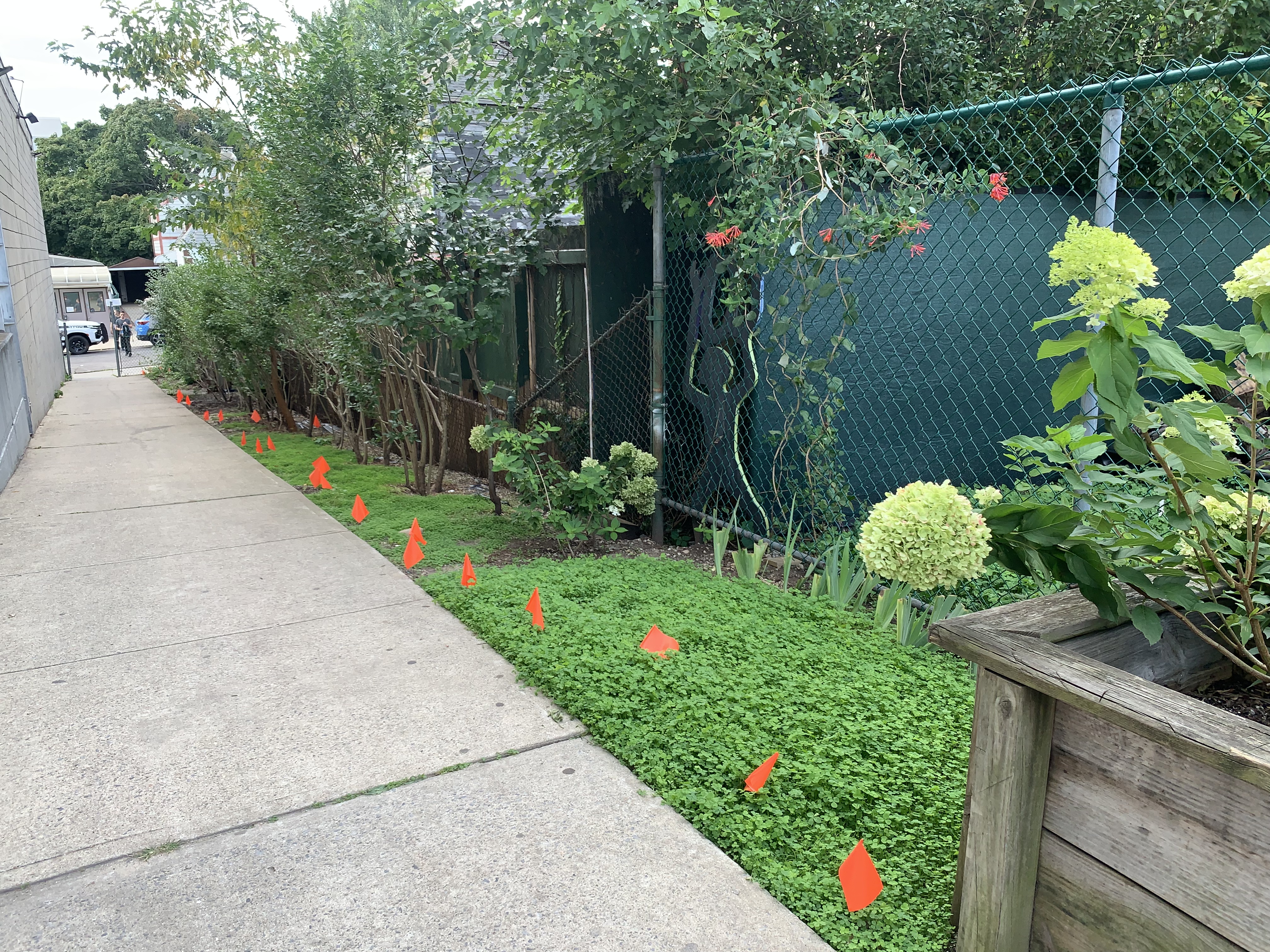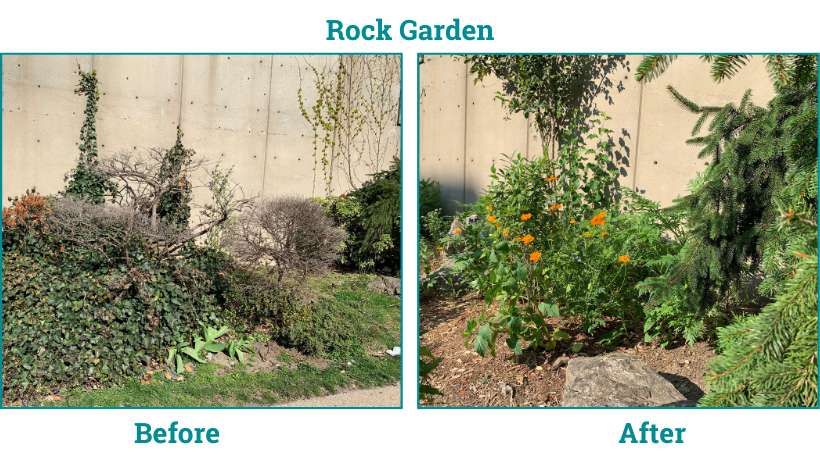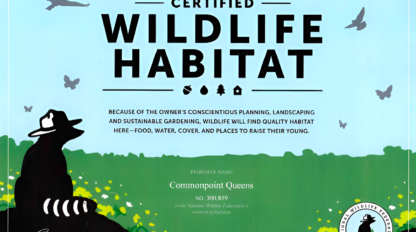Common Ground Gardening Blog: Reflecting on Our Commonpoint Grounds Beautification Project: Look-Back, Progress, and Prospects

It has been nearly three years since Commonpoint launched its Ground Beautification project. Time to recap, identify areas for improvement, and discuss some exciting plans for the upcoming season. This review should also serve as a reminder that every part of the project owes its success to the hard work and dedication of our Garden Volunteers, along with over a hundred children aged 3 to 12 from four Commonpoint’s early childhood and youth programs.
THE ALLEYWAY
Let’s begin our alleyway transformation. It divides the CommonPoint property, with the main building located to the west and the Pantry, Pantry Garden, and Playground situated to the east. This area is open to the public and often serves as a pedestrian shortcut between 67th Road and 67th Avenue.
This area has long been in need of a little love. Some community members have described it as “drab. ” Admittedly, the spread of English ivy along the sidewalk has made it challenging to keep the 4’ x 85’ strip attractive. I have strong feelings about English ivy, which I shared at length in a previous blog post. In a nutshell, I believe English ivy is an aggressive, invasive species that adds little to the ecosystem and poses a serious threat to our garden’s biodiversity. It suffocates all flowers and trees in its path, harbors pests, traps garbage and collects city dust.
With the help of volunteers, we systematically (and, to be honest, gleefully!) pulled out the vines, freeing the privets struggling under a deadly tangle of Boston and English ivy. We also gave our privets a light trim to open up the space. By early March, they were due for a more drastic pruning, which they got two weeks ago. It will promote sturdier branches and denser foliage.
Once we cleared the ground around the shrubs, our Nursery Summer Camp children stepped in to plant clover. In just two weeks, the “gloomy” stretch had transformed into a vibrant shade of lush green. While the clover didn’t fare well during the fall drought, children from the Nursery Enrichment program will soon toddle out of their classrooms and happily resow clover seeds in that strip soil.
THE 108TH STREET STRIP
The strip of grounds between 67th Avenue and the main entrance to Commonpoint has three distinct segments. At 67th Avenue, the fenced plot is undergoing soil remediation. The second segment runs from the fenced plot to the first large ball-shaped Japanese Spindle tree. The last and third segments include the Rock Garden and the group of Japanese Spindles, Pieris, and Norway Spruce flanking the stairs to the main entrance. That is about 8.5’ x 112’ of a semi-arid microclimate.
Once Lost, Now Found
A long-standing project was the reclamation of our corner property at 108 Street and 67th Avenue. Since my predecessor in the Garden, Jonathan Shevin, set up that corner to grow as a pocket-size Native woodland, it has always presented a few challenges due to the nearby Q23 bus stop, heavy foot traffic, and poor soil quality. Desperate to ever grow anything in that area, I began calling it the “Lost Plot.” In 2023, with the participation of two CommonPoint youth programs, Kids Korner and Summer of Arts and Sports, we cleaned up the area and started the long soil amendment process.
Soil amendment is a multi-year process. Two years ago, we started with a 20’ x 11’ rectangle of a rock-solid mix of dusty clayish dirt and stones entirely devoid of organic life. One could hardly distinguish that patch of dirt from the nearby concrete sidewalk. It was clear that no self-respecting plant would ever set roots on that desiccated piece of land.
Water absorption and retention became our first order of business. Last fall, two garden staff members and three brave volunteers spent four weeks completing the project’s first phase. With gray granite cobblestones donated by the Queens Botanical Garden, we made an edge on two sides of the plot to stop the rain waters flowing down our grounds’ slope from escaping onto the 67th Ave sidewalk and gutter. A two-inch tall water dam—if you will.
Then we dug down 1 foot of the rocky mix and sifted out all the stones and pebbles. To finish, we established an inexpensive but healthy garden base. The process, called lasagna, varies with what you have around the house and garden. Imagine a clean-out-the-fridge style recipe to feed your soil. By mid-November, we planted daffodils. You may now come and see for yourself. This spring, for the first time in 3 years, you will enjoy an early splash of vibrant yellow on that once-drabby street corner.

The Rock Garden That Rocks
The Rock Garden beautification project began in 2023 as a Kids Korner Garden Club initiative. That spring, the children in grades 3 to 6 did a fantastic job cleaning the area of ivy, weeds, dead branches, and trash. They learned soil amendment and improved the plot with a mix of coir, compost, and perlite. When summer came, the grounds were ready for planting. As the Summer of Arts and Sports (SAS) camp started, campers took over the project and began planting many of the perennial flowers you could still see last summer. Then Kids Korner resumed in the fall, adding nearly a hundred daffodil bulbs to the Rock Garden.
Throughout 2024, the Rock Garden expanded towards Commonpoint’s main entrance. You might remember the explosion of prairie flowers that graced our main facade through summer and fall.
From the beginning, the Rock Garden has presented its own set of challenges. The plot faces south-west and receives five to six hours of afternoon sun during summer days. From June to September, in the heat radiating from the building’s white walls, the adjacent sidewalk, and the pavement, temperatures often reach a balmy 97, creating a quasi-semi-arid microclimate. At that point, the soil becomes hydrophobic. It squarely refuses to absorb water, no matter how hard and long you try.
And here is the thing: gallons of rain or tap water won’t do any good if the soil can’t retain and absorb moisture. The entire front strip follows the slope of 108th Street. Over a decade, rainwaters had washed away the topsoil down the block all the way to 67th Avenue drains. The erosion had left behind a woeful patch of compacted dust and rocks that could hardly support plant life. Meanwhile, the English ivy never got the memo and kept thriving, engulfing the weaker plants, including some trees that eventually dried out and died. Watering that patch of compacted dust and rocks in the summer heat was pointless; the water just sat on the surface, evaporated within minutes, or ran down the slope.
In 2023, a modicum of soil amendment reduced the impact of rain erosion. Nevertheless, plants were still exposed to a semi-arid microclimate with long periods of unseasonal drought. Remember last fall? Twenty-nine days without rain. That was the second-longest rainless streak in the City’s recorded history, after the fall of 1924, which experienced thirty-six rainless days (cf. Madison Square Park Conservancy). However, rainless days represent only a portion of a drought, which Meriam & Webster defines as “a prolonged period of abnormally low rainfall, leading to a shortage of water.” You may recall the miserly drizzle that hardly reached the ground in November. Adding the rainless days to the “abnormal rainfall” days resulted in a whopping forty-day drought! That one won first place in the City’s recorded drought history.
Rumor has it that these prolonged periods of abnormally low rainfall will become the new normal. Yet, you saw our little desert bloom last summer. And you’ll see it bloom again this coming summer. We owe this apparent miracle to the wisdom of British gardener Beth Chatto (1923-2018), who introduced a new approach to gardening. She summarized it in one simple phrase that became the watchword of gardeners worldwide: “Right Plant, Right Place
In the context of our Rock Garden, this requires finding plants that would survive the soil we have rather than attempting to change the soil and waste a lot of water to accommodate plants that wouldn’t naturally survive this harsh environment. Last summer, “Right Plant, Right Place” translated as a vibrant display of Native wildflowers, grasses, and shrubs along our main façade. You’ll see them again this year; in the golden yellow and orange range, there will be our Gaillardias (aka Indian Blanket flowers), Butterfly Weeds, and Evening Primroses; in white, pink, and purple, you’ll see Four O’Clocks, Mountain Mint, Milkweeds, Creeping Phlox, and in May, our Serviceberry’s delicate blossoms. You’ll also see our Creeping Juniper and a variety of Native Grasses. And we hope to surprise you with more colors, flowers, and prairie grasses. We may even add a shrub, starting with a Viburnum from The New York Restoration Project Free Tree Giveaway. If you need a free tree, you may want to check them out.
The Commonpoint grounds beautification project continues. On the 108th Street strip, we still need to address the section that connects the fenced plot to the Rock Garden. Removing dead trees, English ivy, and other weeds took two summers. We finished with a layer of compost topped with mulch. Except for a Red Prunus and a White Mulberry, nothing grows there. But it looks tidy.

The Forlorn Lawn—but not for long.
Our latest project, still a work in progress, runs along 67th Road from the 108th Street corner to the Butterfly Garden at the Alleyway entrance. If you walked by, you could not have missed the deplorable state of our lawn. In fact, “lawn” doesn’t quite describe the grounds there. Last fall, an attempt at remediating the soil and sowing a new ground cover met with limited success because of the drought. We experimented with multiple turf alternatives, such as micro-clover and low-mow or no-mow grasses. The ideal ground cover must tolerate frozen grounds and droughts while surviving moderate foot traffic and dogs’ calls of nature. However, as on the 108th Street Strip, before we start sowing, we will need to address soil deficiencies and amendment. Lawns and lawn alternatives have been a hot topic for the past couple of years in the horticultural world and will be the subject of a future blog post.
Besides lawn alternatives, there is a tried-and-true method of fixing a wilting lawn: get rid of it. We chose that option at the corner of 67th Road and 108th Street, around the bed of topiaried Northern White Cedars and Pieris. To be fair, when we decided to work on that corner, we stepped into a crime scene: the turf had been almost entirely overwhelmed by the scourge of our gardens: the infamous goosegrass. From the wall to the sidewalk, nothing else grew but those unappealing flat rosettes of dull green blades stretching in the dust. With the SAS campers in tow, we pulled out most of them. We added some of our coconut coir/perlite/compost mix to the soil, planted daffodil bulbs in full sun, and Cardinal flowers in dappled sun. A few weeks ago, we transplanted New York Blue Aster and sowed a few other wildflowers, mostly Gaillardia.


And then there is the Butterfly Garden. Jonathan Shevin planted it about 10 years ago at the other end of the 67th Road lawn. The Butterfly Garden has its own story, which will be the subject of a summer blog.
And Now?
Now, we wait; we hope for both rain and sun; and now we sow. Forty-eight tomato plants of four varieties and forty-eight pepper plants of three varieties, along with Marigolds, Boc Choi, and Arugula, are slowly germinating even as I type. The children in the Nursery Enrichment Program have already sown a dozen beans (2K) and fifty Sunflowers (3-4K). Everything is sprouting vigorously, and last Friday, they transplanted the fifty seedlings into larger pots. Soon, the children will proudly bring their sunflowers home and continue caring for them on their own, while a few plants will remain at Commonpoint. You’ll soon notice our sunflowers—the giant Lemon Queens and fluffy Teddy Bears—nodding and smiling at you as you walk by. It’s okay to smile back…
And, if you see a gardener engaged in a conversation with a bumblebee or a robin chick, don’t hesitate to interrupt to ask questions. Our favorite thing, right after gardening, is talking about it—even with humans.



